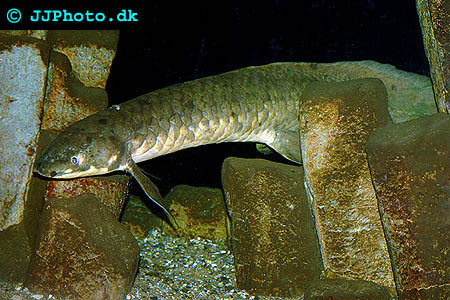Tag Archives: Neoceratodus forsteri
Lungfish died caught in trees
Up to 50 lungfish, some of them up to on metre long, was killed when tonnes of water was released from an Australian dam this week.
The water was released from the North Pine Dam in southeast Queensland between Monday morning and Tuesday night as heavy rains were threatening to overfill the dam.
According to SEQWater, who manages the North Pine Dam, up to 100 native fish went with the release, including roughly a dozen lungfish. SEQWater spokesman Mike Foster said staff were on the scene at every dam release to check for “fish kills” and that they had rescued a handful of lungfish from pools. He also stated that staff would return on Thursday [today] to see if more could be done.
In May, when the North Pine Dam opened its gates for the first time in many years, up to 150 lungfish were rescued.
Roger Currie, spokesman for the Wide Bay Burnett Conservation Council, said conservationists on the scene during the most recent water release had found up to 50 lungfish that had been killed or mutilated as a result of the release.
“Some were found caught in trees yesterday and last night,” Currie said. “They’ve just been pummelled by the sheer force of it.”
The Wide Bay Burnett Conservation Council is pushing for a study to find out how large the North Pine Dam lungfish population is, and the council is also calling for measures to protect fish during water releases.
Lungfish of the species Neoceratodus forsteri.
Copyright www.jjphoto.dk
What’s so special about the Australian lungfish?
The Queensland lungfish, Neoceratodus forsteri, is the only now living member of the family Ceratodontidae and order Ceratodontiformes. Also known as Australian lungfish or Barramunda, Neoceratodus forsteri is native only to the Mary and Burnett river systems in south-eastern Queensland. It has however been introduced to several other Australian rivers south of this area during the past century.
Fossil records of the lungfish group date back 380 million years to a period when the higher vertebrate classes were at the starting point of their development. Prehistoric fossils unearthed in New South Wales are almost identical to the now living Qeensland lungfish, indicating that this species hardly has evolved at all during the last 100 million years. Lungfishes flourished during the Devonian period (c. 413-365 million years ago) but only six species of freshwater lungfish remain today; one in Australia, one in South America, and four in Africa.
The Queensland lungfish can survive for several days out of water, but only if kept moist. It can breathe oxygen directly from the air using its lung-like swim bladder. This species is remarkably long-lived compared to most other fish species and will usually attain an age of at least 20-25 years if it manages to survive into adulthood. Granddad, a Queensland lungfish living at the Shedd Aquarium in Chicago, is at least 80 years old. He has been housed at the aquarium since 1933 and seen many generations of zoo keepers come and go. The largest
